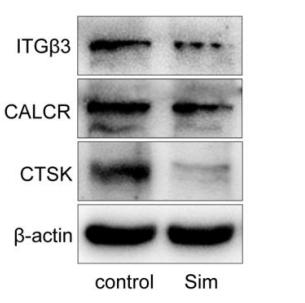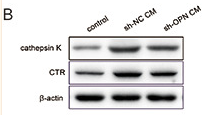CALCR Antibody - #DF10202
| Product: | CALCR Antibody |
| Catalog: | DF10202 |
| Description: | Rabbit polyclonal antibody to CALCR |
| Application: | WB IHC IF/ICC |
| Cited expt.: | WB |
| Reactivity: | Human, Mouse |
| Prediction: | Pig, Zebrafish, Bovine, Horse, Sheep, Rabbit, Dog, Chicken, Xenopus |
| Mol.Wt.: | 59 kDa; 55kD(Calculated). |
| Uniprot: | P30988 |
| RRID: | AB_2840781 |
Related Downloads
Protocols
Product Info
*The optimal dilutions should be determined by the end user. For optimal experimental results, antibody reuse is not recommended.
*Tips:
WB: For western blot detection of denatured protein samples. IHC: For immunohistochemical detection of paraffin sections (IHC-p) or frozen sections (IHC-f) of tissue samples. IF/ICC: For immunofluorescence detection of cell samples. ELISA(peptide): For ELISA detection of antigenic peptide.
Cite Format: Affinity Biosciences Cat# DF10202, RRID:AB_2840781.
Fold/Unfold
Calcitonin receptor; Calcitonin receptor precursor; CALCR; CALCR_HUMAN; CT R; CT-R; CTR; CTR1;
Immunogens
A synthesized peptide derived from human CALCR, corresponding to a region within N-terminal amino acids.
- P30988 CALCR_HUMAN:
- Protein BLAST With
- NCBI/
- ExPASy/
- Uniprot
MRFTFTSRCLALFLLLNHPTPILPAFSNQTYPTIEPKPFLYVVGRKKMMDAQYKCYDRMQQLPAYQGEGPYCNRTWDGWLCWDDTPAGVLSYQFCPDYFPDFDPSEKVTKYCDEKGVWFKHPENNRTWSNYTMCNAFTPEKLKNAYVLYYLAIVGHSLSIFTLVISLGIFVFFRSLGCQRVTLHKNMFLTYILNSMIIIIHLVEVVPNGELVRRDPVSCKILHFFHQYMMACNYFWMLCEGIYLHTLIVVAVFTEKQRLRWYYLLGWGFPLVPTTIHAITRAVYFNDNCWLSVETHLLYIIHGPVMAALVVNFFFLLNIVRVLVTKMRETHEAESHMYLKAVKATMILVPLLGIQFVVFPWRPSNKMLGKIYDYVMHSLIHFQGFFVATIYCFCNNEVQTTVKRQWAQFKIQWNQRWGRRPSNRSARAAAAAAEAGDIPIYICHQEPRNEPANNQGEESAEIIPLNIIEQESSA
Predictions
Score>80(red) has high confidence and is suggested to be used for WB detection. *The prediction model is mainly based on the alignment of immunogen sequences, the results are for reference only, not as the basis of quality assurance.
High(score>80) Medium(80>score>50) Low(score<50) No confidence
Research Backgrounds
This is a receptor for calcitonin. The activity of this receptor is mediated by G proteins which activate adenylyl cyclase. The calcitonin receptor is thought to couple to the heterotrimeric guanosine triphosphate-binding protein that is sensitive to cholera toxin.
Receptor for calcitonin but is unable to couple to G proteins and activate adenylyl cyclase. Does not undergo receptor internalization following ligand binding.
Cell membrane>Multi-pass membrane protein.
Belongs to the G-protein coupled receptor 2 family.
Research Fields
· Environmental Information Processing > Signaling molecules and interaction > Neuroactive ligand-receptor interaction.
· Organismal Systems > Development > Osteoclast differentiation. (View pathway)
References
Application: WB Species: rat Sample: Osteoclast
Application: WB Species: Human Sample: SaOS-2 cells
Restrictive clause
Affinity Biosciences tests all products strictly. Citations are provided as a resource for additional applications that have not been validated by Affinity Biosciences. Please choose the appropriate format for each application and consult Materials and Methods sections for additional details about the use of any product in these publications.
For Research Use Only.
Not for use in diagnostic or therapeutic procedures. Not for resale. Not for distribution without written consent. Affinity Biosciences will not be held responsible for patent infringement or other violations that may occur with the use of our products. Affinity Biosciences, Affinity Biosciences Logo and all other trademarks are the property of Affinity Biosciences LTD.




